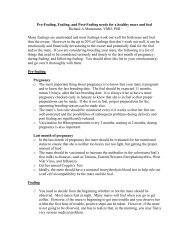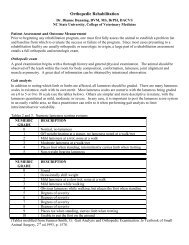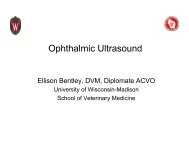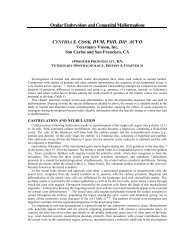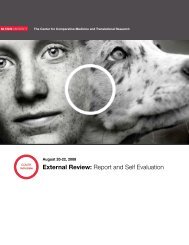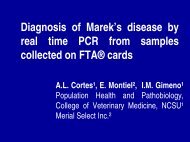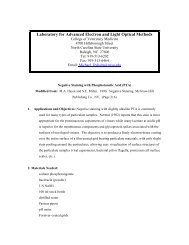complications of phaco
complications of phaco
complications of phaco
You also want an ePaper? Increase the reach of your titles
YUMPU automatically turns print PDFs into web optimized ePapers that Google loves.
Funduscopic Interpretation<br />
Gillian McLellan<br />
Christine Heinrich
Fundus ≠ Retina<br />
• basic knowledge <strong>of</strong> fundus anatomy<br />
• how to evaluate the fundus systematically<br />
• normal fundus variants<br />
• hallmarks <strong>of</strong> fundus pathology
Fundus anatomy<br />
• Vitreous normally optically clear<br />
• Only retinal vessels / pigmented RPE +/- inner choroid<br />
(tapetum) normally visible
Retinal Vascular Patterns<br />
Merangiotic<br />
Paurangiotic<br />
Anangiotic
Fundus anatomy<br />
• light traverses 8 retinal layers to<br />
reach photoreceptors<br />
• photoreceptors largely responsible<br />
for translucent appearance <strong>of</strong> NSR<br />
• cone density highest in area centralis<br />
or macula<br />
• RPE = single cell layer<br />
• Pigmented /non-tapetal<br />
• Tapetal / non-pigmented
tapetum<br />
• structure within the choroid<br />
• cellular in dog and cat<br />
• regular compacted collagen array in ruminants,<br />
horses<br />
• visible due to absence <strong>of</strong> pigment in<br />
overlying RPE<br />
• seen ophthalmoscopically as a bright, shiny<br />
sweep <strong>of</strong> color (or not)
Tapetal development<br />
• RPE completely pigments<br />
during fetal development<br />
• Autophagy <strong>of</strong> melanin occurs<br />
in presumptive tapetal zone<br />
• RPE depigments<br />
• Tapetal maturation is not<br />
complete until 12-1414 weeks <strong>of</strong><br />
age in dogs and cats
In areas <strong>of</strong> thin<br />
tapetum choroidal<br />
vessels may<br />
segmentally<br />
shine through, in<br />
some cases the<br />
long posterior<br />
ciliary artery, or<br />
vortex veins may<br />
also be seen
Tapetal variation in equine fundus
Feline tapetum – transient variant
Normal Ophthalmoscopic Features<br />
• non-tapetal<br />
fundus<br />
Varies in color<br />
depending on<br />
amount <strong>of</strong> melanin<br />
in RPE and choroid<br />
RPE contains melanin,<br />
tapetum absent
Normal Ophthalmoscopic Features<br />
• non-tapetal<br />
fundus<br />
• (optic disc)<br />
• (retinal blood vessels)<br />
RPE contains melanin,<br />
where the tapetum is absent.<br />
Choroid darkly pigmented<br />
Reflection from internal limiting<br />
membrane may be prominent here and<br />
this is also a good place to evaluate<br />
nerve fiber layer with a red free light
Nerve fiber layer may be visible
etinal vasculature and optic nerve head
hallmarks <strong>of</strong> retinal disease<br />
• altered tapetal reflectivity<br />
• changes in pigmentation<br />
• vascular changes<br />
• haemorrhage<br />
• altered optic nerve head appearance
Words <strong>of</strong> Advice<br />
• Record your findings at the time!<br />
• Take photos if possible<br />
• Try to explain in terms <strong>of</strong> underlying<br />
histopath<br />
• Consider other funduscopic features, ocular<br />
or systemic findings that you might expect to<br />
find in conjunction with the presumed<br />
“abnormality”<br />
• Re-evaluation evaluation – progressive disease?
Still can’t decide?<br />
• Use higher mag./change viewing angle?<br />
• Red-green filter?<br />
• Second opinion?<br />
• Functional testing - electrophysiology<br />
• Is there a genetic test?<br />
• Consider other imaging techniques<br />
• Fluorescein angio, OCT, cSLO/<br />
aut<strong>of</strong>luorescence imaging
tapetal reflectivity<br />
retina<br />
RPE<br />
tapetum<br />
choroid<br />
sclera
altered tapetal reflectivity<br />
retina<br />
RPE<br />
tapetum<br />
choroid<br />
normal<br />
reflectivity<br />
hyperreflectivity<br />
sclera<br />
hyporeflectivity
increased tapetal reflectivity<br />
• associated with retinal thinning<br />
• Degeneration<br />
• Detachment
increased tapetal reflectivity<br />
retina<br />
tapetum<br />
sclera<br />
RPE
educed tapetal reflectivity<br />
• associated with increased retinal thickness<br />
• folding<br />
• edema<br />
• cellular infiltration<br />
• subretinal effusion (incl. detachment)<br />
• Associated with choroidal infiltrates /fibrosis
educed tapetal reflectivity<br />
retina<br />
tapetum<br />
sclera<br />
RPE
altered fundus pigmentation<br />
• appearance <strong>of</strong> pigment in tapetal fundus<br />
• post-inflammatory<br />
• aberrant metabolites<br />
• Lipopigment (RPED)<br />
• loss <strong>of</strong> pigment in non-tapetal<br />
fundus<br />
• post-inflammatory<br />
• degenerative retinal disease (PRA)
Courtesy R. Riis
etinal thickness and the non-tapetal fundus<br />
• tapetum absent<br />
• lesions associated with<br />
increased retinal<br />
thickness visible as<br />
gray areas
etinal vasculature<br />
• attenuation<br />
• sclerosis<br />
• hemorrhage<br />
• congestion<br />
• increased tortuosity<br />
• pallor<br />
• anemia<br />
• lipemia
BSH colourpoint 1 yr
B<br />
Vitreous<br />
A<br />
C<br />
C<br />
D<br />
D<br />
A<br />
B<br />
Sclera
Lipemia<br />
retinalis +<br />
anemia
optic nerve head changes<br />
• size<br />
• swelling<br />
• inflammation<br />
• associated with hemorrhages, infiltrates<br />
• depression / cupping<br />
• pallor<br />
• associated with loss <strong>of</strong> vasculature<br />
• Associated with gliosis
5m Standard Poodle
UC Davis<br />
R. Bellhorn
5 y Pyrenean Mountain Dog
UC Davis
Jan 2011<br />
Feb 2011<br />
Jan 2012
Fundoscopy ≠ Pathology ≠ Etiology



